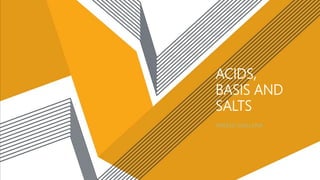
Acids, Bases and Salts Explained
- 2. Reduced Syllabus For 2021 Examination 8. ACIDS, BASES ANDSALTS Introduction 8.2 8.2.2 Relative Strength of Acids and Bases 8.3 Conjugate Acid-Base Pairs 8.4 Strength of Acids and Bases 8.4.1 Ionization Equation of Water and calculation of PH and POH in aqueous medium using given Kw values. 8.4.2 Strong and weak acid 8.4.3 Strong and weak base 8.4.4 Relationship of Ka and Kb 8.6 Buffer Solutions and their Applications 8.7 Salt Hydrolysis
- 3. Introduction: Acids: sour taste react with “active” metals • e.g., Al, Zn, Fe, but not Cu, Ag, or Au • 2 Al + 6 HCl → 2 AlCl3 + 3 H2 • corrosive react with carbonates, producing CO2 • marble, baking soda, chalk, limestone • CaCO3 + 2 HCl → CaCl2 + CO2 + H2O change color of vegetable dyes • blue litmus turns red react with bases to form ionic salts Bases: also known as alkalis taste bitter • alkaloids = plant product that is alkaline • often poisonous solutions feel slippery change color of vegetable dyes • different color than acid • red litmus turns blue react with acids to form ionic salts • neutralization
- 4. Properties of Salts: Salts are water-soluble ionic compounds. Salts that contain the cation of a strong base and an anion that is the conjugate base of a weak acid are basic. • NaHCO3 solutions are basic. • Na+ is the cation of the strong base NaOH. • HCO3 − is the conjugate base of the weak acid H2CO3. Salts that contain cations that are the conjugate acid of a weak base and an anion of a strong acid are acidic. • NH4Cl solutions are acidic. • NH4 + is the conjugate acid of the weak base NH3. • Cl− is the anion of the strong acid HCl.
- 5. 8.2: Bronsted Lowery Concepts for Acids and Bases • lone pair bond • bond lone pair Lewis acid–base theory focuses on transferring an electron pair. does NOT require H atoms • electron rich; therefore, nucleophile The electron donor is called the Lewis base. • electron deficient; therefore, electrophile The electron acceptor is called the Lewis acid.
- 6. Conjugate Acids Base Pairs
- 7. 8.4: Strength of Acids and Bases Strong Acids: An acid which can donate proton to a higher degree of than another acid is said to be strong acid. For example HCl. Ability of an acid to donate proton is called strength of acids. Strong Base: A base which can accept proton to higher degree than another base is called strong base and the ability of a base to accept proton is called strength of base. For example Ammonia is a strong base.
- 8. Ionization Constant of Water and calculation of pH and pOH Using Kw value Water is a unique compound, it can donate proton as well as accept proton. Like that
- 11. Salt Hydrolysis It is defined as the reaction of the cation or anion of the salt with water to produce either acidic or basic solution. Consider a salt 𝑴𝑿 is dissolved in water, It splits up into its 𝑴+ and 𝑿− ions. Cations come from base and anions come from acid 𝑴+ + 𝑯 − 𝑶𝑯 ↔ 𝑴𝑶𝑯 + 𝑯+ 𝑿− + 𝑯 − 𝑶𝑯 ↔ 𝑯𝑿 + 𝑶𝑯− Since 𝑯+ and 𝑶𝑯− ions are produced in these reactions, the solution of the salt may be acidic or basic.
- 12. Types of Salts on the basis of reactivity with water Salts of strong acid and strong base Salts of weak acid and strong base Salts of strong acid and weak base Salts of weak acid and weak base
- 17. Type of Salt Common examples Ions which impart hydrolysis Solution pH Acid Base Strong Strong NaCl, NaBr None =7.0 (Neutral) Strong Weak 𝑵𝑯 𝟒 𝑵𝑶 𝟑, 𝑵𝑯 𝟒 𝑪𝒍 Cations <7.0 (Acidic) Weak Strong NaCN, 𝑲 𝟐 𝑪𝑶 𝟑 Anions >7.0 (Basic) Weak Weak 𝑵𝑯 𝟒 𝑪𝑵, 𝑵𝑯 𝟒 𝑵𝑶 𝟐 Both Smaller, Equal or greater
